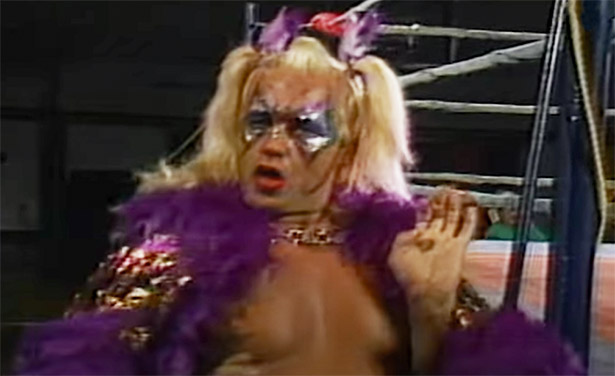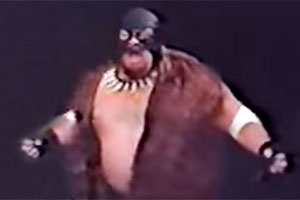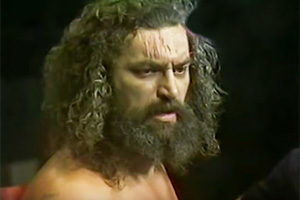Adrian Street Death – Sepsis
1940-2023 (Age 82)

70s and 80s wrestling star Adrian Street, dead at 82.
Adrian Street was a man who refused to settle. He was willing to go to great lengths to succeed, even if it meant adopting a strange persona
Nonetheless, his drive to succeed and willingness to do things his way made him a cultural icon and one of pro wrestling’s most outrageous stars.
“I Was Born for the Spotlight”
Adrian Street was born on December 5, 1940, in Brynmawr, Wales. He had a tumultuous relationship with his father, who had been a Japanese prisoner of war in World War II.
Adrian said he tried to justify his dad’s enmity for him due to his being a POW but he noted his dad got along well with the rest of his siblings.
Prior to the war, Adrian’s father had worked in the coal mines since he was a young teen. His father insisted he would work in the mines, despite his son’s objection.
Adrian worked in the coal mines for about a year, enduring the cruel conditions common to miners, a profession that was usually the only job available to anyone in the area.
Nonetheless, the youngster dreamed of something more. He attended wrestling matches when he could and read about the squared circle in wrestling magazines.
Street had big dreams and was committed to achieving them. He would recall, “Too dark down there, I was born for the spotlight,” however, at just 5’7” and 150 pounds, a career in wrestling seemed unlikely. Undeterred, Street left home, training himself in bodybuilding and wrestling while working as a boxer at local carnivals.
A Countercultural Icon
Adrian Street’s wrestling persona was more than bold. It was more than daring. It was downright revolutionary and an inspiration to some of Great Britain’s best-known artists. For example, rocker Marc Bolan claims he modeled his look after “Exotic” Adrian.
In addition, British artist Jeremy Deller would write about Street.
“symbolic of the [journey] Britain took at the time … from a country that relied on industry, to one that has since relied on entertainment and services … he was a trailblazer.”
Deller took note of a 1973 picture with Adrian and his dad. BBC News’ obituary of Street described what made the picture stand out, not only for Deller but for many others:
…a photo by Dennis Hutchinson taken of Street alongside his father in 1973 was called by Turner Prize-winning artist Jeremy Deller the “most important post-war picture ever taken.” It showed Street dressed in full wrestling garb standing defiantly next to his father and the other miners at Blaenau Gwent Colliery. Many argued the image represented the beginning of the UK’s shift from heavy industry into the entertainment age.
Deller described what made the photo so important as it showed the dynamic between the now-successful Adrian and the men who had ridiculed his dreams:
“a revenge photograph …going back to the pit, where he’d been bullied, teased and laughed at, to show his father and the guys in the pit what he’d made of himself and how proud he was of how he looked.”
Street’s continued success in and out of the ring only strengthened the case that he was more than just a wrestling star; he was a pop culture icon.
Adrian appeared in the films The Canterbury Tales, Quest for Fire, and Grunt: The Wrestling Movie. He was also the subject of two documentaries, Jeremy Deller’s The Life and Times of Adrian Street and Joann Randles’ You May Be Pretty, But I Am Beautiful: The Adrian Street Story
Smartening Up
Street is believed to have debuted in 1957 as Kid Tarzan Jonathan. Unfortunately for the would-be scrapper, he was unaware of wrestling’s worked nature and believed matches were legitimate sporting contests. This proved disastrous for his opponent as Street took things seriously and dislocated his opponent’s shoulder.
Needless to say, the promoter wasn’t happy with Kid Tarzan’s blunder. Luckily for Street, he was given another chance and sent for further training, eventually learning about the world of kayfabe. Still, it took time as Street was shocked at what he discovered:
“I was disappointed that it wasn’t real. I never got over that. I’d stuck up for it for so long and argued with people, trying to convince ‘em it was real, but I really didn’t have a clue.”
Somehow Street reconciled himself to the reality of professional wrestling, accomplishing much during his career.
Feeding Off the Fans
Early on, Street adopted a flamboyant outfit, bleaching his hair and commissioning a seamstress to adorn him in a blue velvet and silver lame outfit, complete with powder blue boots that ran up to his knees. The results were jeers, boos, and catcalls from his fellow wrestlers and the fans.
Street doubled down on his outrageous act:
“So I was like, ‘Right, if that’s what the silly buggers want then that’s what I’ll give them’ and I made my character all the more extreme by skipping around the ring and planting big lip-stick smackers on my opponents’ faces.”
Street wasn’t the first wrestler to cultivate an effeminate look. During the 1950s, “Gorgeous” George adopted an act, but it was nowhere near as daring as Street’s. Adrian would reflect on his early days in his new guise:
“Okay, I didn’t get the reaction I wanted but it was still more of a response than anyone else got that night, so I just pushed the envelope further and further.”
Eventually, the act paid off, with Street achieving success in the UK including championships and plenty of publicity.
From One Side of the Pond to the Other
After establishing himself in Europe, Adrian Street sought bigger opportunities in North America. By 1981, he had grown bored with the wrestling scene in the United Kingdom. However, his act would translate in North America.
According to Wales Online, Street began his North American career in Mexico:
“A stint in Mexico under the billing Adrian El Exotico gave him the ‘Exotic’ Adrian Street monicker with which he’d later become known, while he and his wife and manager Linda (herself a fellow wrestler) would balance their spandex showdowns with a successful costume-making business, The Bizarre Bazaar.”
Street proved successful in many territories including Calgary Stampede Wrestling, Memphis, Championship Wrestling from Florida, Mid-South Wrestling, Jim Crockett Promotions, and others.
In Memphis’ Continental Wrestling Association, Street often teamed with Miss Linda and manager Jim Cornette in handicap matches against babyfaces such as The Fabulous Ones or “Superstar” Bill Dundee.
During his career in North America, Street clashed with established stars such as Jerry “The King” Lawler as well as rising stars like Bret Hart, Bobby Fulton, and Davey Boy Smith.
Although Street often began as a heel, shrewd promoters knew how to turn him babyface. Street had some unlikely but popular pairings including teams with Jimmy Valiant in Jim Crockett Promotions and Dusty Rhodes in Championship Wrestling from Florida.
Eventually, “Exotic” Adrian and Miss Linda decided to stay in Alabama’s Continental Championship Wrestling. With his manager Miss Linda, Street knew exactly how to get heel heat.
He also knew how to market himself. Street released records which babyfaces would break. This led to fans buying the records just so they could break them. Whether anyone listened to the music was irrelevant as Street laughed all the way to the bank.
Later Life
Could someone as full of life as “Exotic” Adrian Street truly settle down?
Street wrote eight memoirs and continued operating a clothing store (The Bizarre Bazaar) where he and Miss Linda designed outfits for anyone looking for something that would stand out. Given his colorful outfits, customers were confident no look was off limits.
Wrestlers such as Mick Foley and actor Mickey Rourke (who purchased ring attire for his role in The Wrestler) were well-known clients.
A Well-Deserved Thrashing
One of the Street’s proudest achievements was the beating he dished out to Jimmy Saville, a well-known celebrity who was later exposed as a pedophile. The UK Guardian would report Street was asked to wrestle Savile a draw. Savile, who had reportedly stolen part of Street’s act, asked that Street wrestle him to a draw:
“Insulted by the suggestion, and already disliking Savile, he physically punished the disc jockey, even tearing out his hair while holding him upside down. Years later Street said if he had known Savile’s true nature, he would have hurt him much more.”
Although the allegations against Saville would not be proven for decades, Street claims Saville boasted about sleeping with underage girls, something which did not go over well with the wrestler.
The Epitome of a Survivor
Street’s hardscrabble life motivated him to strive for a way out. Once he established himself, he had no intent of checking out soon whether it was cancer. In 2001, a doctor diagnosed him with terminal cancer and told him to “put your affairs in order.” Adrian’s spirited response?
“I just told him I wasn’t going anywhere because there were still people in the world I’d not pissed off yet. I don’t think he appreciated me saying that.”
Street survived.
By this time he was living in Pensacola, Florida where he operated his clothing shop and a wrestling school.
Eventually, the Florida weather proved too much. The humidity was bad enough but when his home was destroyed on two occasions by hurricanes, Street and Miss Linda returned to Wales where children and grandchildren awaited.
Adrian Street Death
Adrian Street died on July 24, 2003, at Cwmbran’s Grange University Hospital. He was 82.
His wife told the BBC:
“He’d had a heart problem a while ago which was resolved. But then he had a stroke earlier this month which resulted in a bleed on the brain. He was recovering from that at home when he developed colitis – a chronic inflammatory bowel disease – which later turned into sepsis. That’s what killed him.”
Other pro wrestlers who died in 2023 include Bray Wyatt, “Superstar” Billy Graham, Mantaur, Butch Miller, Jay Briscoe, Jerry Jarrett, “Leaping” Lanny Poffo, and Terry Funk.
What are your favorite memories of Adrian Street? Let us know in the comments below.





Leave a Reply